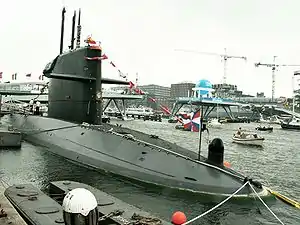HNLMS Zeeleeuw (1987)
HNLMS Zeeleeuw (S803) is a Walrus-class submarine of the Royal Netherlands Navy. She entered service in 1990 as the first submarine of the Walrus class, after the intended lead ship, HNLMS Walrus, was delayed for a long period following a serious fire during construction.[1] Zeeleeuw has been deployed both for naval exercises and in combat operations around the world. Furthermore, the submarine plays an important role by performing intelligence operations.[2] The submarine has undergone a mid-life maintenance and upgrade program between 2014 and 2016, and is currently in active service.[3]
 The Dutch submarine Zeeleeuw at SAIL Amsterdam 2005 | |
| History | |
|---|---|
| Name: | Zeeleeuw |
| Namesake: | Sea lion |
| Builder: | Rotterdamsche Droogdok Maatschappij |
| Yard number: | 349 |
| Laid down: | 24 September 1981 |
| Launched: | 20 June 1987 |
| Commissioned: | 25 April 1990 |
| Identification: | S803 |
| Motto: | Eager for prey |
| Status: | In active service |
| General characteristics | |
| Class and type: | Walrus-class submarine |
| Displacement: |
|
| Length: | 68 m (223 ft 1 in) |
| Beam: | 8.5 m (27 ft 11 in) |
| Draught: | 7.5 m (24 ft 7 in) |
| Propulsion: | Diesel-electric (3,132 kW) |
| Speed: | |
| Test depth: | 300 m (980 ft) |
| Complement: | 55 |
| Armament: | Mark 48 torpedoes and Harpoon missiles |
Activities
- In 2010 HNLMS Zeeleeuw took part in Operation Ocean Shield.[4]
Maintenance and upgrade
In 2014 HNLMS Zeeleeuw was taken out of service after years of service by the Royal Netherlands Navy to perform maintenance and modernize its systems.[5] During the upgrade program, the submarine was upgraded with modern systems.[6] The ageing GIPSY combat system was replaced with the more modern Guardion combat system. Besides changing the software suit, hardware components were either replaced or upgraded with newer versions.[7] The Medium Range Sonar (MRS) and Long Range Sonar (LRS) were replaced. A new sonar was added, the Mine and Obstacle Avoidance Sonar (MOAS). The consoles and screens in the command room were upgraded to more modern versions, while the navigation and attack periscopes went from being depended on analog sensors to digital sensors. This was done by replacing several masts. Lastly, the Mark 48 torpedoes were upgraded from mod 4 to the more recent mod 7.[8]
See also
- Ships of the Royal Netherlands Navy
References
- Defensie, Ministerie van. "Zr. Ms. Zeeleeuw". www.defensie.nl (in Dutch). Retrieved 2017-11-26.
- Defensie, Ministerie van (2015-11-30). "Onderzeeboten". www.defensie.nl (in Dutch). Retrieved 2017-11-26.
- Defensie, Ministerie van. "IPW maakt Zeeleeuw beter dan ooit". www.defensie.nl (in Dutch). Retrieved 2017-11-26.
- Defensie, Ministerie van. "Onderzeeboot beëindigt antipiraterij-missie Ocean Shield". www.defensie.nl (in Dutch). Archived from the original on 2018-07-23. Retrieved 2018-07-22.
- Karremann, Jaime. "Instandhoudingsprogramma Walrusklasse (IP-W)". www.marineschepen.nl (in Dutch). Retrieved 2017-11-26.
- "Imtech Marine gaat onderzeeërs moderniseren". www.binnenvaartkrant.nl (in Dutch). Archived from the original on 2018-06-22. Retrieved 2018-03-26.
- Kesseler, André (13 May 2013). "Upgrade Nederlandse onderzeeboten van start" (in Dutch). Retrieved 22 June 2018.
- Twigt, André (June 2016). "Kop van Instandhoudingsproject Walrusklasse is er af". Retrieved 25 November 2017.
External links
| Wikimedia Commons has media related to S803 Zr.Ms. Zeeleeuw (submarine, 1990). |